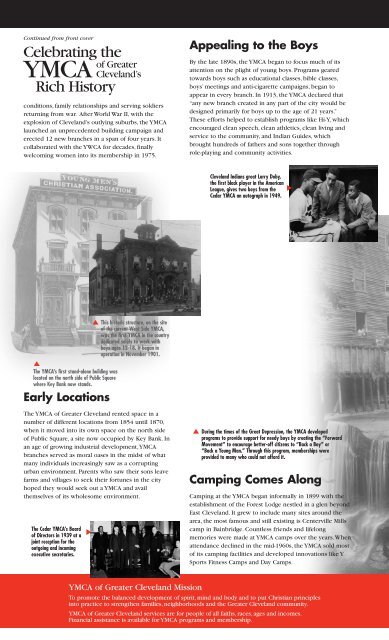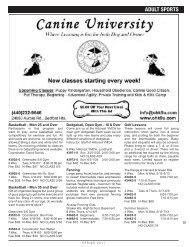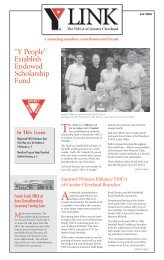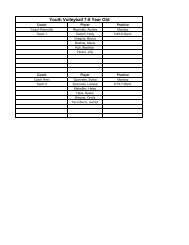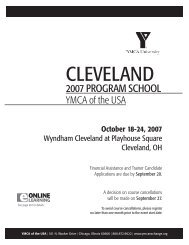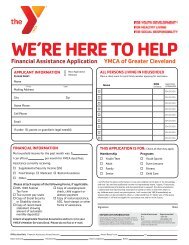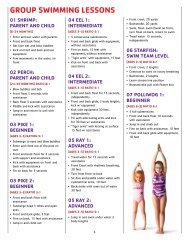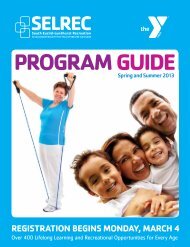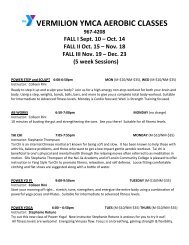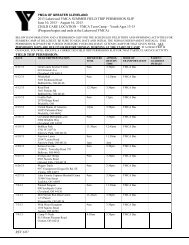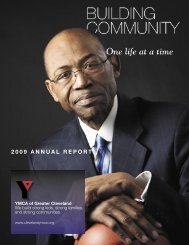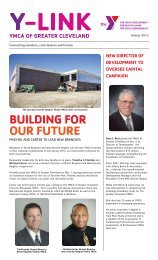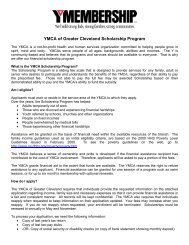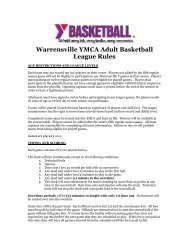Winter 2004 - the YMCA of Greater Cleveland
Winter 2004 - the YMCA of Greater Cleveland
Winter 2004 - the YMCA of Greater Cleveland
Create successful ePaper yourself
Turn your PDF publications into a flip-book with our unique Google optimized e-Paper software.
Continued from front cover<br />
Celebrating <strong>the</strong><br />
<strong>YMCA</strong><br />
Rich History<br />
<strong>of</strong> <strong>Greater</strong><br />
<strong>Cleveland</strong>’s<br />
conditions, family relationships and serving soldiers<br />
returning from war. After World War II, with <strong>the</strong><br />
explosion <strong>of</strong> <strong>Cleveland</strong>’s outlying suburbs, <strong>the</strong> <strong>YMCA</strong><br />
launched an unprecedented building campaign and<br />
erected 12 new branches in a span <strong>of</strong> four years. It<br />
collaborated with <strong>the</strong> YWCA for decades, finally<br />
welcoming women into its membership in 1975.<br />
Appealing to <strong>the</strong> Boys<br />
By <strong>the</strong> late 1890s, <strong>the</strong> <strong>YMCA</strong> began to focus much <strong>of</strong> its<br />
attention on <strong>the</strong> plight <strong>of</strong> young boys. Programs geared<br />
towards boys such as educational classes, bible classes,<br />
boys’ meetings and anti-cigarette campaigns, began to<br />
appear in every branch. In 1913, <strong>the</strong> <strong>YMCA</strong> declared that<br />
“any new branch created in any part <strong>of</strong> <strong>the</strong> city would be<br />
designed primarily for boys up to <strong>the</strong> age <strong>of</strong> 21 years.”<br />
These efforts helped to establish programs like Hi-Y, which<br />
encouraged clean speech, clean athletics, clean living and<br />
service to <strong>the</strong> community, and Indian Guides, which<br />
brought hundreds <strong>of</strong> fa<strong>the</strong>rs and sons toge<strong>the</strong>r through<br />
role-playing and community activities.<br />
<strong>Cleveland</strong> Indians great Larry Doby,<br />
<strong>the</strong> first black player in <strong>the</strong> American<br />
League, gives two boys from <strong>the</strong><br />
Cedar <strong>YMCA</strong> an autograph in 1949.<br />
This historic structure, on <strong>the</strong> site<br />
<strong>of</strong> <strong>the</strong> current West Side <strong>YMCA</strong>,<br />
was <strong>the</strong> first <strong>YMCA</strong> in <strong>the</strong> country<br />
dedicated solely to work with<br />
boys ages 12-18. It began in<br />
operation in November 1901.<br />
The <strong>YMCA</strong>’s first stand-alone building was<br />
located on <strong>the</strong> north side <strong>of</strong> Public Square<br />
where Key Bank now stands.<br />
Early Locations<br />
The <strong>YMCA</strong> <strong>of</strong> <strong>Greater</strong> <strong>Cleveland</strong> rented space in a<br />
number <strong>of</strong> different locations from 1854 until 1870,<br />
when it moved into its own space on <strong>the</strong> north side<br />
<strong>of</strong> Public Square, a site now occupied by Key Bank. In<br />
an age <strong>of</strong> growing industrial development,<strong>YMCA</strong><br />
branches served as moral oases in <strong>the</strong> midst <strong>of</strong> what<br />
many individuals increasingly saw as a corrupting<br />
urban environment. Parents who saw <strong>the</strong>ir sons leave<br />
farms and villages to seek <strong>the</strong>ir fortunes in <strong>the</strong> city<br />
hoped <strong>the</strong>y would seek out a <strong>YMCA</strong> and avail<br />
<strong>the</strong>mselves <strong>of</strong> its wholesome environment.<br />
The Cedar <strong>YMCA</strong>’s Board<br />
<strong>of</strong> Directors in 1939 at a<br />
joint reception for <strong>the</strong><br />
outgoing and incoming<br />
executive secretaries.<br />
During <strong>the</strong> times <strong>of</strong> <strong>the</strong> Great Depression, <strong>the</strong> <strong>YMCA</strong> developed<br />
programs to provide support for needy boys by creating <strong>the</strong> “Forward<br />
Movement” to encourage better-<strong>of</strong>f citizens to “Back a Boy” or<br />
“Back a Young Man.” Through this program, memberships were<br />
provided to many who could not afford it.<br />
Camping Comes Along<br />
Camping at <strong>the</strong> <strong>YMCA</strong> began informally in 1899 with <strong>the</strong><br />
establishment <strong>of</strong> <strong>the</strong> Forest Lodge nestled in a glen beyond<br />
East <strong>Cleveland</strong>. It grew to include many sites around <strong>the</strong><br />
area, <strong>the</strong> most famous and still existing is Centerville Mills<br />
camp in Bainbridge. Countless friends and lifelong<br />
memories were made at <strong>YMCA</strong> camps over <strong>the</strong> years.When<br />
attendance declined in <strong>the</strong> mid-1960s, <strong>the</strong> <strong>YMCA</strong> sold most<br />
<strong>of</strong> its camping facilities and developed innovations like Y<br />
Sports Fitness Camps and Day Camps.<br />
<strong>YMCA</strong> <strong>of</strong> <strong>Greater</strong> <strong>Cleveland</strong> Mission<br />
To promote <strong>the</strong> balanced development <strong>of</strong> spirit, mind and body and to put Christian principles<br />
into practice to streng<strong>the</strong>n families, neighborhoods and <strong>the</strong> <strong>Greater</strong> <strong>Cleveland</strong> community.<br />
<strong>YMCA</strong> <strong>of</strong> <strong>Greater</strong> <strong>Cleveland</strong> services are for people <strong>of</strong> all faiths, races, ages and incomes.<br />
Financial assistance is available for <strong>YMCA</strong> programs and membership.


